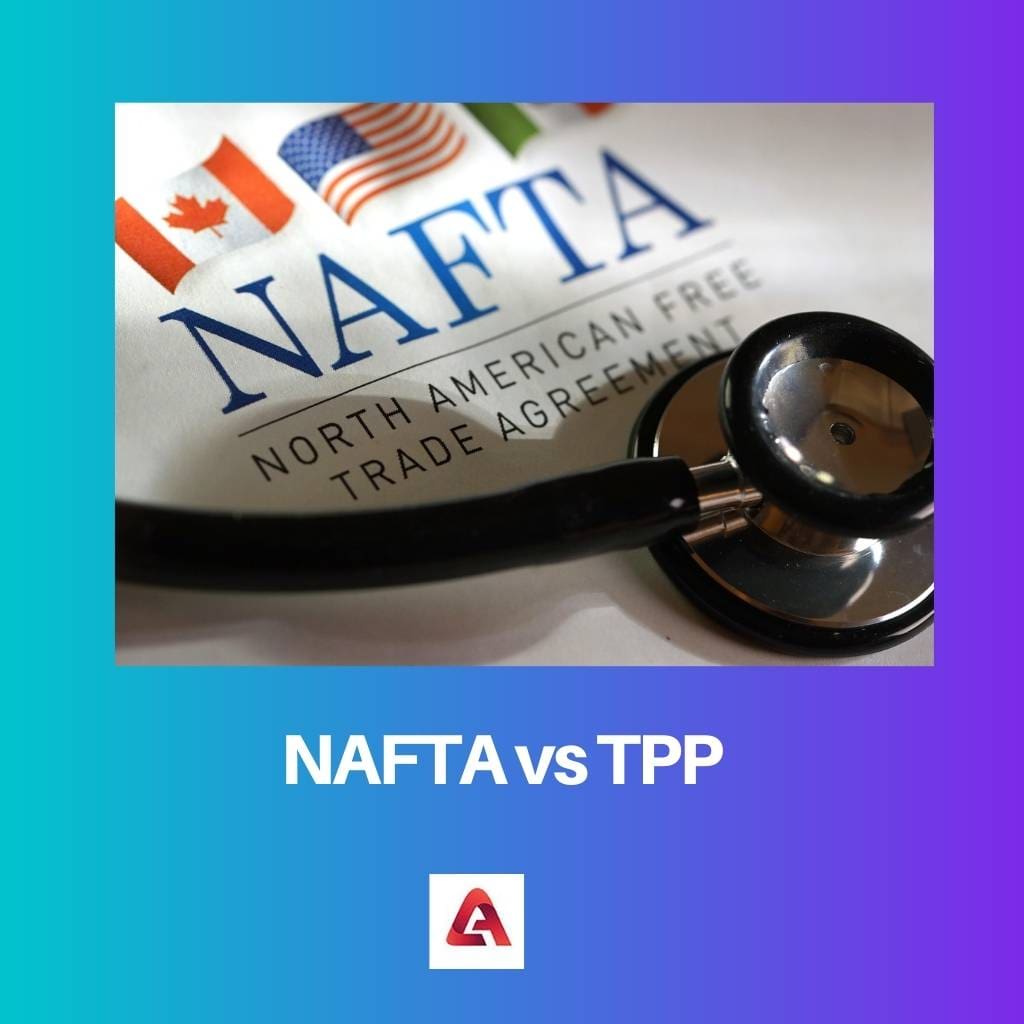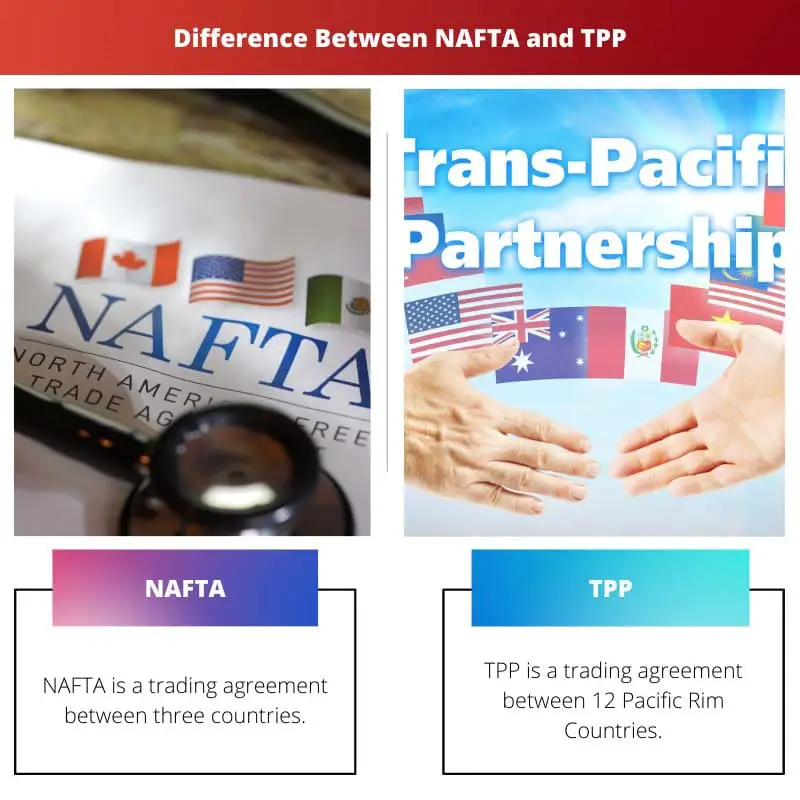We have 195 Countries in the world. Every country has its businesses and, the companies desire to spread their business through the world. NAFTA and TPP are the agreements between the countries that help in trading and business.
Key Takeaways
- NAFTA stands for North American Free Trade Agreement, an agreement between Canada, Mexico, and the United States to eliminate trade barriers between the three countries.
- TPP stands for Trans-Pacific Partnership, an agreement between 12 countries, including the United States, Canada, Mexico, Japan, Australia, and New Zealand, to reduce trade barriers and promote economic growth in the Asia-Pacific region.
- NAFTA focuses on trade between North American countries, while TPP focuses on trade between the Asia-Pacific and the Americas.
NAFTA vs TPP
NAFTA (North American Free Trade Agreement) is a trade agreement between the US, Canada, and Mexico that aims to promote economic cooperation and reduce trade barriers. The TPP (Trans-Pacific Partnership) is a proposed trade agreement with 12 countries, but the US withdrew from it in 2017.

NAFTA derives the ‘North America Free Trade Agreement’ that eliminates the barriers between Mexico, Canada and the United States in marketing.
The Mexican president, the Canadian Prime Minister and the United States President signed the agreement in 1992, and it took effect in 1994 on January 1st. The trilateral trade bloc had started and continued between the three Countries.
TPP is an agreement between the 12 countries of the Pacific Rim. TPP stands for Trans-Pacific Partnership. The 12 countries involved in the TPP agreement are the United States, Malaysia, Mexico, Australia, Japan, New Zealand, Peru, Singapore, Brunei, Canada, Chile and Vietnam.
The TPP agreement had signed on February 4th, 2016. The TPP trade is the largest free trade deal on the earth and covers 40 per cent of the global economy.
Comparison Table
| Parameters of Comparison | NAFTA | TPP |
|---|---|---|
| Meaning | NAFTA is a trading agreement between three countries. | TPP is a trading agreement between 12 Pacific Rim Countries |
| Derivation | NAFTA stands for North America Free Trade Agreement. | TPP had derived as Trans-Pacific Partnership. |
| Establishment | NAFTA had established in 1992 and effect on 1st January 1994. | TPP had established on 4th February 2016. |
| Countries Involved | The agreement had agreed upon between Mexico, Canada and the United States. | The TPP agreement had held between Australia, Canada, Chile, Japan, Brunei, Malaysia, Mexico, New Zealand, Vietnam, Peru, United States and United States Countries. |
| Purpose | NAFTA eliminates the tariffs, non-tariffs of exports and imports between three countries. | TPP helps to trade between the 12 Pacific Countries. It supports providing middle-class jobs at good wages. |
What is NAFTA?
NAFTA is an agreement which had signed by Mexico, Canada and the United States. The abbreviation of NAFTA is North America Free Trade Agreement. NAFTA is a marketing agreement between the three countries.
NAFTA eliminate the tariff and non-tariff barriers between the three countries and helps in business. The establishment of NAFTA took place in 1992 in North America, and its effect on January 1st, 1994.
The goal of NAFTA formation is to reduce trade costs and to increase business investments.
The legislatures in NAFTA had inspired by the European Economic Community’s success. It had established in 1953 to eliminate the tariffs among its members. NAFTA also involves agreements on international trading with business investors.
NAFTA helps reduce the cost of commerce. It encourages small businesses to invest and grow. Languages used in the NAFTA are English, Spanish and French.
Most of the research says that NAFTA benefits the North American people and the average citizen and harms the small minority workers who work in industries.
NAFTA replaced the agreement of the Canada-United States, which had been established in 1988 between Canada and the United States. In 2017, the President of America’ Donald Trump, decided to replace NAFTA.
In September 2018, the United States, Mexico and Canada reached an agreement on NAFTA and replaced it with USMCA. USMCA stands for United States-Mexico-Canada-Agreement, and it had confirmed in March 2020.
NAFTA had worked until the USMCA had approved. NAFTA was good for GDP and possessed good diplomatic relations. The drawback of NAFTA is, it leads to the loss of manufacturing jobs in the United States.

What is TPP?
TPP is an agreement between the 12 Pacific Countries. The TPP had derived as Trans-Pacific Partnership.
The 12 countries, Australia, Canada, Chile, Japan, Peru, Singapore, United States, Vietnam, New Zealand, Mexico, Malaysia and Brunei, signed in the TPP agreement on 2016 February 4th. TPP is the centrepiece of Barak Obama’s strategy toward Asia.
But, the president of America, ‘Donald Trump’ withdrew from the United States in 2017. TPP agreement was the massive free deal trade in the World, and 40 per cent of the global economy had covered.
TPP used to support middle-class jobs with good wages and small investment businesses. The benefits of the formation of the Trans-Pacific Partnership are
- It had eliminated 18,000 plus income taxes that had been made in American exports.
- The workers used to get good wages at middle-class jobs.
- TPP was the first agreement that focused on central and small businesses.
After the withdrawal of the United States, the legislatures of 11 countries agreed and replaced the TPP with CPTPP in December 2018. Comprehensive and Progressive Trans-Pacific Partnership (CPTPP) allowed other countries to give membership.
The TPP announced the new regulations by allowing online commerce, foreign investors, comprehensive protection for intellectual property, labour codes and many others.
According to the United States Trade Representative (USTR), TPP is the first harmful trade for fish that contributed to overfishing. TPP had enforced anti-corruption laws and regulations.

Main Differences Between NAFTA and TPP
- NAFTA is an agreement between three countries about business and marketing, whereas TPP is an agreement between 12 Pacific Rims Countries.
- NAFTA had signed in 1992 and took effect in 1994 on January 1st. In Contrast, TPP had signed on 4th February 2016.
- NAFTA have the best diplomatic relation where TPP have eliminated 18,000 plus income taxes.
- NAFTA stands for North America Free Trade Agreement, and TPP stands for Trans-Pacific Partnership.
- Both NAFTA and TPP are agreements for businesses, but NAFTA is between 3 countries. On the Other hand, the TPP agreement between 12 countries, which the U.S. had quit in 2017.

- https://heinonline.org/hol-cgi-bin/get_pdf.cgi?handle=hein.journals/txamrpl5§ion=15
- https://www.rieti.go.jp/en/events/16071201/pdf/16_pm2-1_leycegui.pdf
- https://books.google.com/books?hl=en&lr=&id=EDsuDwAAQBAJ&oi=fnd&pg=PA1&dq=+NAFTA+and+TPP+&ots=szoGNYoaKe&sig=vaXe2k66enRowbhHG6iKOcN3bWE

The evolution of NAFTA into USMCA is a significant development and highlights the ongoing changes in international trade agreements.
I completely agree, Ybaker. It’s crucial to stay informed about these shifts in trade policy and their implications.
Absolutely, Ybaker. The transition from NAFTA to USMCA reflects the dynamic nature of global commerce and diplomacy.
The interplay of political dynamics in impacting trade agreements like TPP highlights the complexity of international relations and economic cooperation.
Absolutely, Mpatel. Examining the political influences on trade agreements provides valuable insights into the larger geopolitical implications of such accords.
The in-depth explanation of NAFTA and TPP helps clarify their respective purposes and significance in international trade.
Well put, Lily Clarke. Delving into the details of these agreements is essential for comprehending their impact on global economics.
Very interesting read! It’s fascinating to learn about these trade agreements and the impact they can have on the global economy.
Absolutely, Katie72! These agreements can have far-reaching effects on the world’s economic landscape.
I completely agree. Understanding the differences between NAFTA and TPP is crucial for anyone interested in global trade and commerce.
The impact of NAFTA on GDP and manufacturing jobs in the United States is an important consideration when evaluating its effects on the economy.
Well said, Becky Powell. Understanding the economic consequences of NAFTA provides valuable insights into its advantages and drawbacks.
The role of TPP in promoting middle-class jobs and economic growth underscores its significance in shaping the Asia-Pacific region’s economic landscape.
I completely agree, Jennifer19. TPP’s impact on job creation and economic development is crucial for understanding its implications for the Asia-Pacific nations.
The breakdown of the key takeaways and the comparison between NAFTA and TPP is well done. It really helps clarify the main differences and objectives of each agreement.
The historical context provided for NAFTA and TPP is enlightening. It’s important to understand how these agreements originated and evolved over time.
Well said, Frank Davis. Knowing the background of NAFTA and TPP adds depth to our understanding of their significance in global trade.
I couldn’t agree more, Frank Davis. The history behind these agreements sheds light on the motivations and goals of the countries involved.
The detailed comparison table is a great way to summarize the key differences between NAFTA and TPP. It’s a useful reference for anyone studying these trade agreements.
Absolutely, Zoe15. Having a clear overview of the parameters of comparison makes it easier to grasp the distinct features of NAFTA and TPP.
I agree with your assessment, Zoe15. The comparison table is a valuable resource for understanding the nuances of each trade agreement.
The article effectively captures the essence of NAFTA and TPP, shedding light on their intentions and outcomes.
Well said, Hking. The depth of information presented in this article is truly impressive.
I couldn’t agree more, Hking. The insightful analysis provided here offers a comprehensive understanding of these trade agreements.